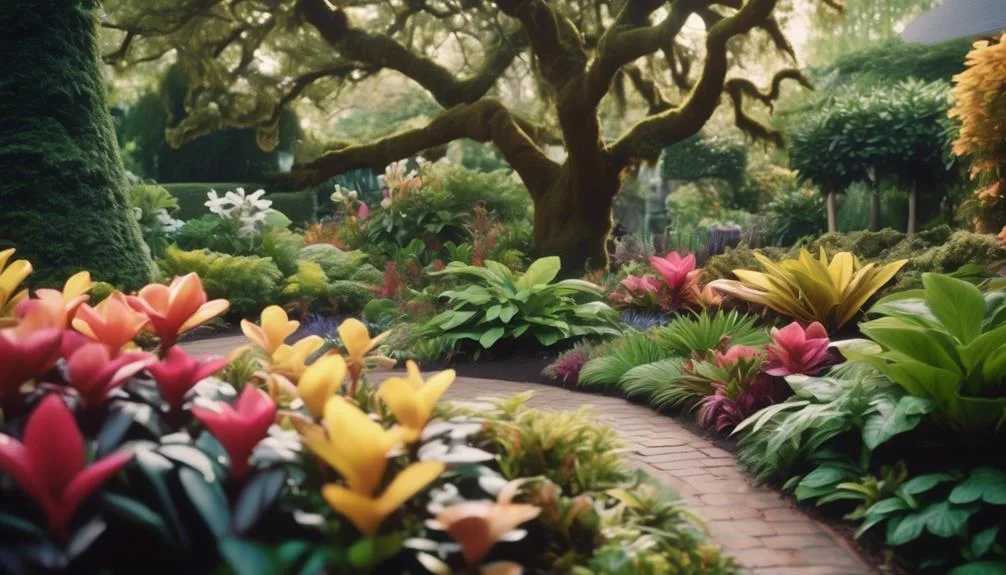Finding the right plants to go with your magnolia tree can make your garden look stunning. Whether you want to complement the beautiful blooms or enhance the foliage, there are plenty of options.
From shade-loving plants to colorful flowering ones, there's a wide variety to choose from. But how do you pick the best companions for your magnolia tree?
Shade-Loving Understory Plants
If you're looking to enhance the area around your magnolia tree, consider adding shade-loving understory plants that thrive in the dappled light provided by the tree's canopy.
Companion plant pairings can help create a harmonious and visually appealing garden bed.
Some excellent shade garden suggestions include planting hostas, ferns, and azaleas. Hostas come in a variety of colors, sizes, and leaf shapes, making them versatile companions for magnolia trees.
Ferns, with their delicate fronds, add a touch of elegance and lushness to the understory, while azaleas provide bursts of color with their vibrant blooms.
These plants not only complement the magnolia tree but also thrive in the shade it provides, creating a beautiful and cohesive garden landscape.
Evergreen Companion Shrubs
Consider adding evergreen companion shrubs to your garden bed around the magnolia tree to provide year-round foliage and structure.
When selecting evergreen shrubs, consider ones that thrive in similar soil conditions and require the same watering schedule as your magnolia tree.
Look for shrubs that are pest-resistant to minimize the need for pest control.
Incorporating evergreen shrubs with similar pruning techniques will make maintenance easier.
Some excellent evergreen companion shrubs for magnolia trees include boxwood, holly, and aucuba.
Boxwood is known for its dense, compact growth and responds well to regular pruning.
Holly shrubs offer vibrant red berries in the winter and thrive in well-drained soil.
Aucuba, with its glossy green leaves, is a hardy shrub that tolerates various soil types.
These shrubs will complement your magnolia tree beautifully while providing year-round interest.
Seasonal Flowering Partners
Looking for seasonal flowering partners to enhance the beauty of your magnolia tree? Consider planting pollinator-attracting flowers such as bee balm, coneflowers, or butterfly weed near your magnolia. These vibrant blooms not only complement the magnolia's blossoms but also help attract beneficial insects to your garden.
For a fragrant bloom pairing, try adding jasmine or gardenias. Their sweet, heady scents can create a delightful sensory experience when enjoyed alongside the magnolia's own fragrance.
Additionally, planting daffodils or tulips around the base of your magnolia can add a pop of color in the spring, further enhancing the visual appeal of your garden.
Ground Cover and Vines
Enhance the visual appeal and health of your magnolia tree by selecting suitable ground cover and vines to complement its growth and aesthetics. Here are some options to consider:
| Ground Cover | Vines | Benefits |
|---|---|---|
| Creeping Phlox | Climbing Hydrangea | Suppresses weeds, retains moisture |
| Vinca Minor | Clematis | Erosion control, adds vertical interest |
| Sweet Woodruff | Jasmine | Attracts beneficial insects |
| Bugleweed | Wisteria | Ground stabilization, adds fragrance |
To ensure the optimal growth of your magnolia tree, consider using mulching techniques to retain moisture and provide a steady release of nutrients. Additionally, implementing pest control and disease prevention measures will safeguard the health of both the magnolia tree and its companion plants. Choose a fertilization schedule that complements the needs of both the tree and its ground cover and vines.
Ornamental Grasses and Ferns
Introduce a touch of elegance and movement to your garden by incorporating ornamental grasses and ferns that complement the beauty of your magnolia tree.
Ornamental grasses such as Japanese forest grass and fountain grass thrive in well-drained, moderately fertile soil. They add texture and subtle color variations to the landscape, creating a harmonious backdrop for your magnolia tree.
Ferns, like autumn fern and lady fern, prefer moist, well-drained soil with plenty of organic matter. These lush green plants provide a striking contrast to the large, glossy leaves of the magnolia tree.
To maintain the ornamental grasses and ferns, regular watering is essential, especially during hot and dry periods. Remove any dead or damaged fronds from the ferns, and trim back the ornamental grasses in late winter or early spring to encourage fresh growth.
Conclusion
Incorporating the right companion plants can elevate the beauty of your magnolia tree, bringing color and harmony to your garden throughout the seasons.
With thoughtful selection, your garden can evolve into a cohesive and stunning landscape that complements the magnificence of the magnolia.
Happy gardening!

My interest in trees started when I first saw the giant sequoias in Yosemite.
I was a teenager then, and I remember thinking, “I need to learn more about this.”
That moment stuck with me.
A few years later, I went on to study forestry at Michigan Tech.
Since graduating, I’ve worked in a mix of hands-on tree care and community education.
I’ve spent over ten years helping people understand how to plant, maintain, and protect the trees in their neighborhoods.
I don’t see trees as just part of the landscape.
They are living things that make a real difference in our daily lives.
